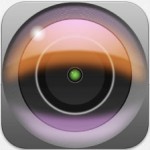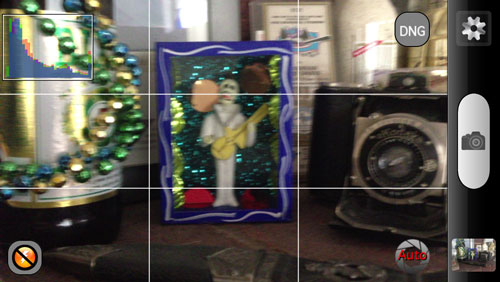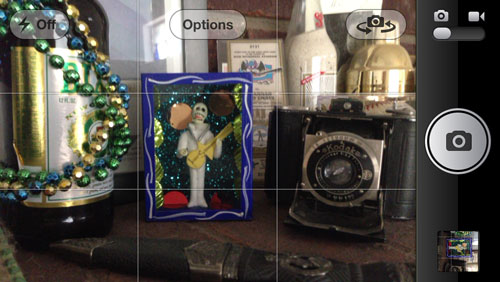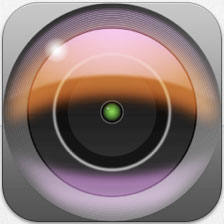Digital Negative
Version Reviewed: 1.0
![]()
Bottom Line: Digital Negative has too many problems, bugs and lack of pro features to be considered for any serious use right now.
 Having RAW format has been the Holy Grail of iPhoneographers for years. New photo app Digital Negative promises us with a flavor of digital RAW, but stumbles very badly in its initial release, to the point where it’s unusable as a camera for shooting high-quality photos in the iPhone.
Having RAW format has been the Holy Grail of iPhoneographers for years. New photo app Digital Negative promises us with a flavor of digital RAW, but stumbles very badly in its initial release, to the point where it’s unusable as a camera for shooting high-quality photos in the iPhone.
I spent some hands-on time with this app over the past couple of days. Keep reading my review of this promising, but very disappointing camera app. >>>
This new photo app is getting a lot of attention because of the potential advanced capabilities it brings to the iPhone camera.
Digital Negative is the first iPhone camera app that captures uncompressed images that retain all of the information recorded by the camera sensor. That’s really cool! These Digital Negative (DNG) pictures are much like the negatives from a film camera, and the serious photographer can use standard RAW editing programs such as Adobe Photoshop for Desktop, or Digital Negative’s built-in raw editing tools to develop the photograph and display all of the features in the image.
Digital Negative saves to its own lightbox as DNG files. These files are similar to RAW files, but differ in a few key ways. According to the app’s manual, Linear DNG, unlike most raw image formats, contains data arranged in a rectilinear R-G-B format. This data has already been demosaiced, but can be edited by all popular raw image editing software such as Adobe Lightroom. You can read more about DNG and RAW files here.
Both formats preserve the settings of the image as shot, including Exposure, Gamma, Contrast, Vibrance, Saturation, etc. You can edit and reedit these settings in the app’s lightbox or tweak the settings when you import images on the desktop in Photoshop. It’s control over an image that serious iPhoneographers have been wanting for years.
It’s a great, high-end workflow that in theory should give you visibly better raw images to work with outside of the iPhone — images with greater color, better exposure and less noise and compression artifacts.
Problem is, there’s way too much wrong with the app, and many of its mission critical tools are flat-out broken in this release.
Digital negative functions as a very basic camera. It’s got some of the features of an advanced camera, but is missing some of the most basic ones like separate Focus and Exposure targets. That’s an essential feature in any high-end camera replacement.
The app has a live, onscreen Histogram to help composing better lit shots. There’s a Rule-of-Thirds composition grid. Both features can be toggled in the app’s settings.
The viewfinder crops the preview in not just a little, but quite a bit. it’s impossible for precision composition in viewfinder. Accuracy is paramount in a high-end camera app. This is another dealbreaking issue. See below. The actual crop of the image had the wider field of view as seen in the Apple Camera — itself an inaccurate viewfinder.

Digital Negative viewfinder

Apple Camera viewfinder
The app’s Darkroom functions as a built-in image editor where you can adjust many of the parameters of the raw image. Original exposure settings are preserved in the DNG file. In theory, you can also go back later and make different moves to the image as you “redevelop” it. It’s professional a workflow I use all the time in production when color correcting, retouching, and color matching images in the studio here.
When the Darkroom module works, it works well. The app is able to make some impressive color and luminance fixes to an image that are visibly better than performing the same moves in other apps. Colors look more natural. Shadows are open with good detail. There is less visible noise, especially in the darker areas of the image. That may have more to do with the processing algorithms, though, than the developers use of a limited DNG format. See my sample images below processed with Digital Negative, PhotoForge2 and the excellent but often overlooked Process app ( ). These were all corrected using these settings: Gamma +25%, Vibrance +25%, Saturation +10%. Nothing major, but enough to make the image pop a little bit.
Here are detail area images:
Unfortunately, several of Digital Negative’s tools are broken. The Exposure tool, The Denoise Tool, and the White Balance Tool all break the image with incorrect hue and saturation aberrations. Adjustments look more like the pixel destroyer Decim8 than from a high-end camera app.

Bugs in Exposure and White Balance tools in Digital negative
After editing, saving over an image saves back as a JPG, not as a DNG which destroys the ability to go back to your raw data. At least a warning would be nice.
DNG files are large. Raw 8 MP files were 30 MB each on my iPhone 5, compared to 1-3 MB of a high-quality JPG. You’ll need the largest capacity device to work with more than a few of these files.
The app has the ability to upload to Dropbox, but the feature is almost useless for what it really needs to be. The large DNG files take up a lot of room on my iPhone and I’d like to move the raw files off to my desktop as soon as possible. The Save to Dropbox feature only saves smaller JPG files that lack the raw data. When it works. The feature crashed often for me.
In fact, Digital Negative has stability issues overall. It crashed unexpectedly for me about 10% of the time during my tests. This was after quitting all apps and rebooting my device.
Opening up the DNG files in the RAW Camera plug-in in Photoshop for Mac was a disaster. The imported raw image (using the default import settings) should have been pretty close to what I shot, needing only minor tweaks to my preference. Instead, colors, saturation and luminance were all unusably way off and the imported image was way too noisy to use, negating any advantages and features of the raw DNG format. My reference raw image imported fine using the same plug-in and settings. Maybe I’m overlooking a setting here?
And here’s what my reference image looked like, same settings:
The in-app help is thorough, but not completely helpful. It’s also unreadable on an iPhone. Here’s a link to the Digital Negative manual on the web. You’ll need an iPad or a desktop to read it. Bad oversight making the help manual unreadable on most of the devices that will be using the app.
I really hated to come down hard on this app, but the expectations are high for a camera app that touts these professional-level features. I was very excited to read what it can do and was looking forward to getting some true high-quality files on my iPhone. However, I feel that the bugs and the lack of some key features make this first try very disappointing.
Many serious iPhoneographers will really tear up and do amazing things with raw format images, especially as the iPhone’s cameras improve. Right now, Digital Negative is not that answer. It could be a game changer when everything is fixed, but right now the app feels more like a late alpha than a real release. The app currently has too many problems, bugs and lack of features to be considered for any serious use.
Digital Negative is $2.99. Requirements: Compatible with iPhone 3GS, iPhone 4, iPhone 4S, iPhone 5, iPod touch (3rd generation), iPod touch (4th generation), iPod touch (5th generation) and iPad. Requires iOS 5.0 or later. This app is optimized for iPhone 5.
=M=
~~~~
Digital Negative for iPhone
Toolbox
Resolution & Image Quality
User Interface
Price / Value
Poor
Many serious iPhoneographers will really tear up and do amazing things with raw format images. Right now, Digital Negative is not that answer. It could be a game changer when everything is fixed, but right now the app feels more like a late alpha than a real release. It has too many problems, bugs and lack of features to be considered for any serious use.












